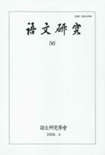- 영문명
- Reflective Contemplation on Reading Folk-tales
- 발행기관
- 어문연구학회
- 저자명
- 김경섭(Kyung-Seop Kim)
- 간행물 정보
- 『어문연구』語文硏究 第56輯, 89~115쪽, 전체 27쪽
- 주제분류
- 어문학 > 한국어와문학
- 파일형태
- 발행일자
- 2008.04.30

국문 초록
영문 초록
It has been commonly thought that tales passed down to us by verbal and literal means have sublime lessons by which we should be guided and thus have been translated such as. Since they have survived so long ages, certain tales, we definitely guess. contain innocent lessons and moral values in themselves. However, it is true that many tales delivered in an story-telling auditorium or theater have not so much exquisite and refined forms as distorted and deteriorated ones. Furthermore, when false interpretations of tale-performers added into the category of the texts of tales. the problems can be made worse.
This thesis is directly aimed at pointing out the problems concerned with the reading and interpretation of tales through investigating the missing parts of a text in reading tales.
In case of oral folk tales, there can be discrepancy between the standpoint of a tale-performer and the contents of a tale. That"s because in his delivery tale-performer can sometimes reveal some biased points of view toward the title-role character of a tale. In 〈"wise woman" folk-tales〉, for instance, the tale-performer"s personal sexual context can have an effect on its entextualization, therefore, treatments toward a woman are heavily accidental and momentary compared with the problem-solving woman. As he or she is not a creator but a herald of a text. any Tale-performer can deliver the text in an irrelevant way or in a just opposite way to the original meaning.
In case of a written folk tale, the deliverer, who is not a creator, either, can have a strong possibility of doing "tale-edit" according to his or her own purpose, thanks to the fact he or she is totally free from the perform-event. Accordingly, contrary to oral folk tales, written folk tales never undertake the process regarded "mistakes."
Seemingly, written folk tales contain highly devised, different meanings, intentionally revealing the problematic editions. SamKuk YouSa(三國遺事), which is made up of a group of tales well organized according to individual parts, can be called the best model. The chapter PiEun(避隱) in SamKukYouSa(三國遺事), a tale unsuitable to its chapter, is awkwardly arranged in its chapter and thus allows the intention of the editor to be highlighted and shown to readers.
This thesis is directly aimed at pointing out the problems concerned with the reading and interpretation of tales through investigating the missing parts of a text in reading tales.
In case of oral folk tales, there can be discrepancy between the standpoint of a tale-performer and the contents of a tale. That"s because in his delivery tale-performer can sometimes reveal some biased points of view toward the title-role character of a tale. In 〈"wise woman" folk-tales〉, for instance, the tale-performer"s personal sexual context can have an effect on its entextualization, therefore, treatments toward a woman are heavily accidental and momentary compared with the problem-solving woman. As he or she is not a creator but a herald of a text. any Tale-performer can deliver the text in an irrelevant way or in a just opposite way to the original meaning.
In case of a written folk tale, the deliverer, who is not a creator, either, can have a strong possibility of doing "tale-edit" according to his or her own purpose, thanks to the fact he or she is totally free from the perform-event. Accordingly, contrary to oral folk tales, written folk tales never undertake the process regarded "mistakes."
Seemingly, written folk tales contain highly devised, different meanings, intentionally revealing the problematic editions. SamKuk YouSa(三國遺事), which is made up of a group of tales well organized according to individual parts, can be called the best model. The chapter PiEun(避隱) in SamKukYouSa(三國遺事), a tale unsuitable to its chapter, is awkwardly arranged in its chapter and thus allows the intention of the editor to be highlighted and shown to readers.
목차
1. 설화 읽기의 문제
2. 이야기 구연자의 측면
3. 이야기 편찬자의 측면
4. 맺음말
참고문헌
Abstract
2. 이야기 구연자의 측면
3. 이야기 편찬자의 측면
4. 맺음말
참고문헌
Abstract
해당간행물 수록 논문
참고문헌
최근 이용한 논문
교보eBook 첫 방문을 환영 합니다!

신규가입 혜택 지급이 완료 되었습니다.
바로 사용 가능한 교보e캐시 1,000원 (유효기간 7일)
지금 바로 교보eBook의 다양한 콘텐츠를 이용해 보세요!


